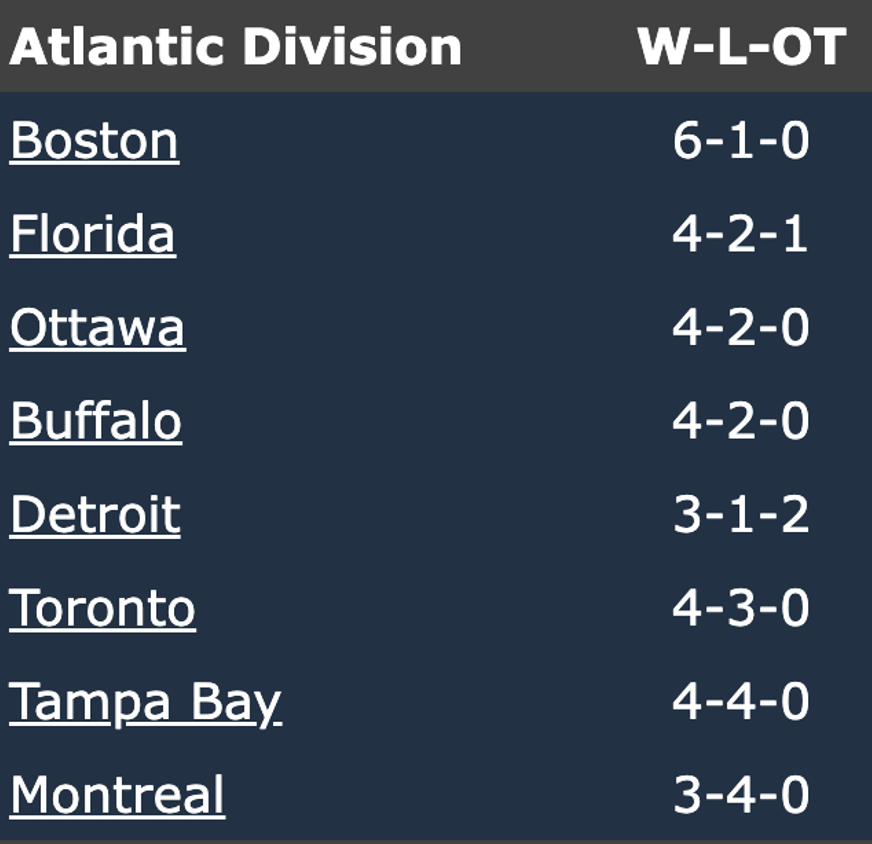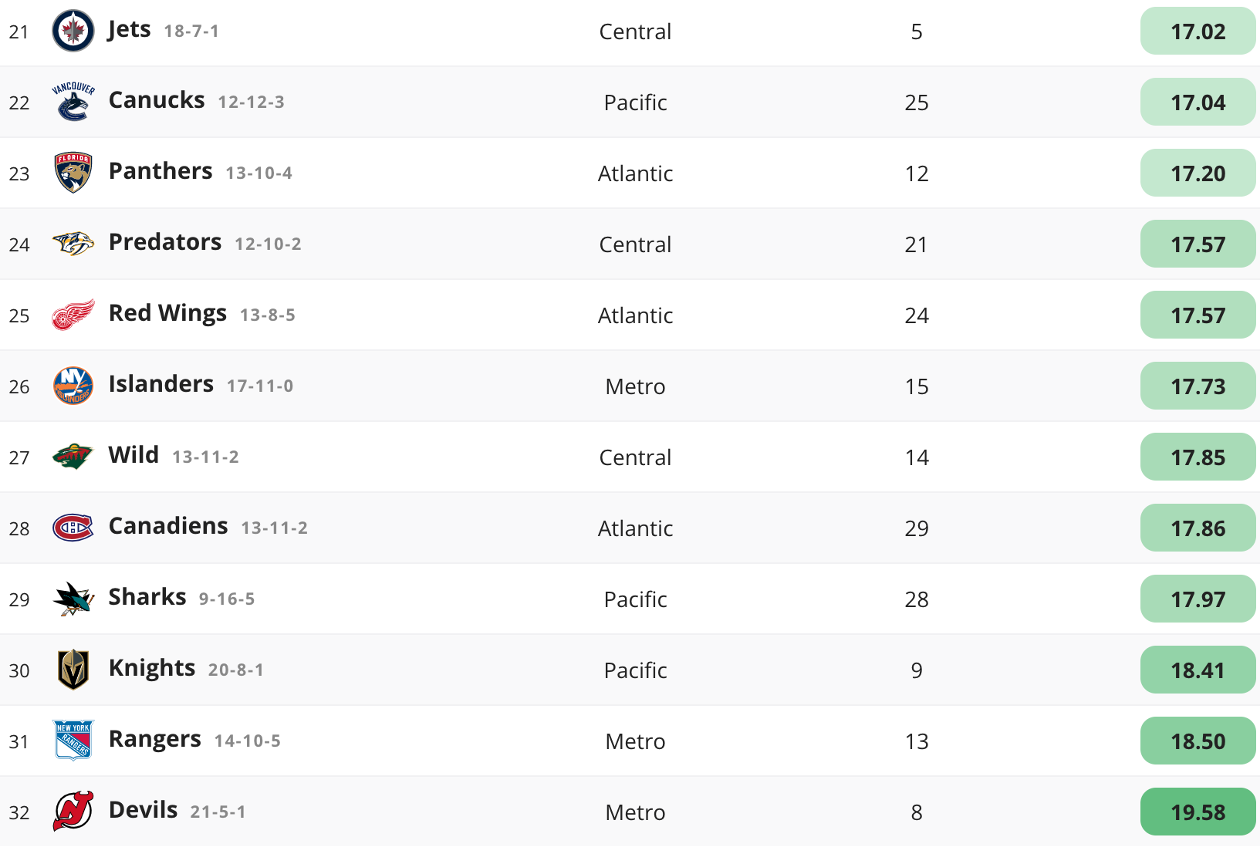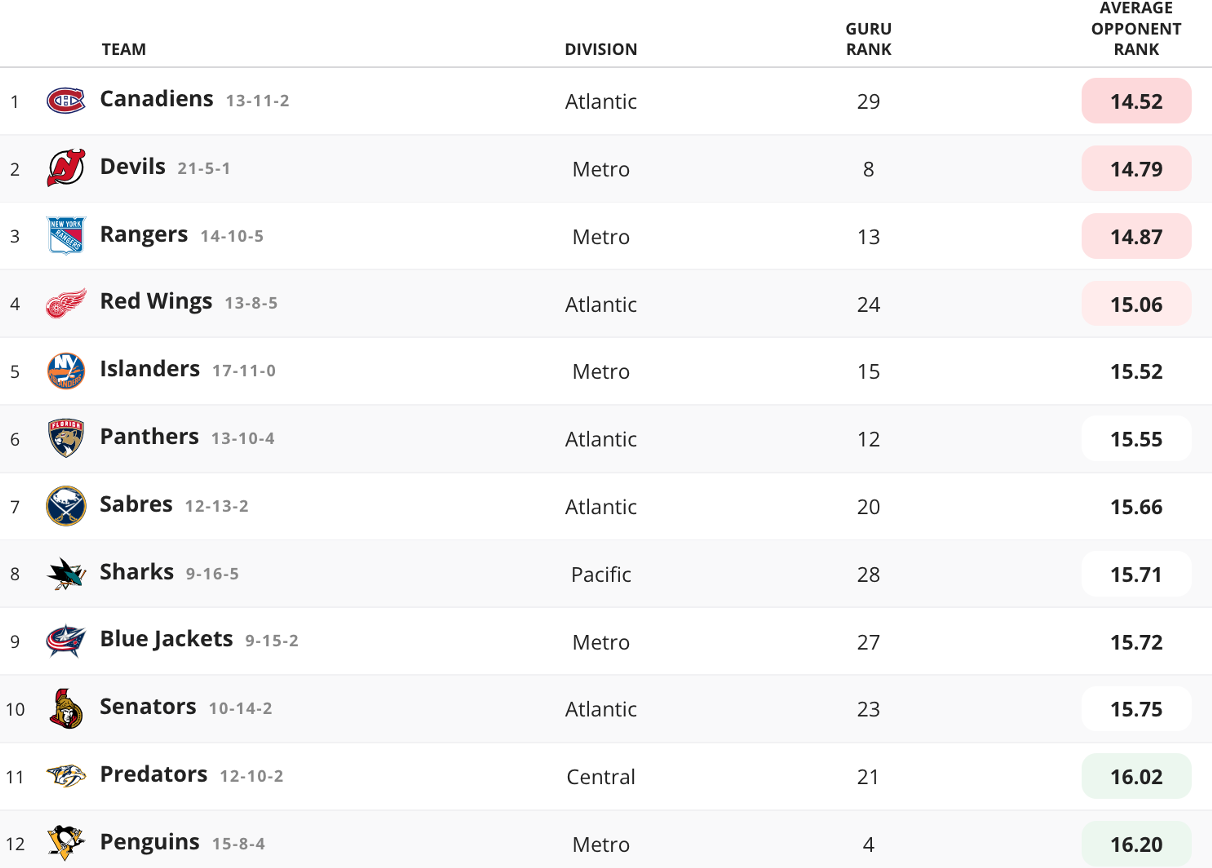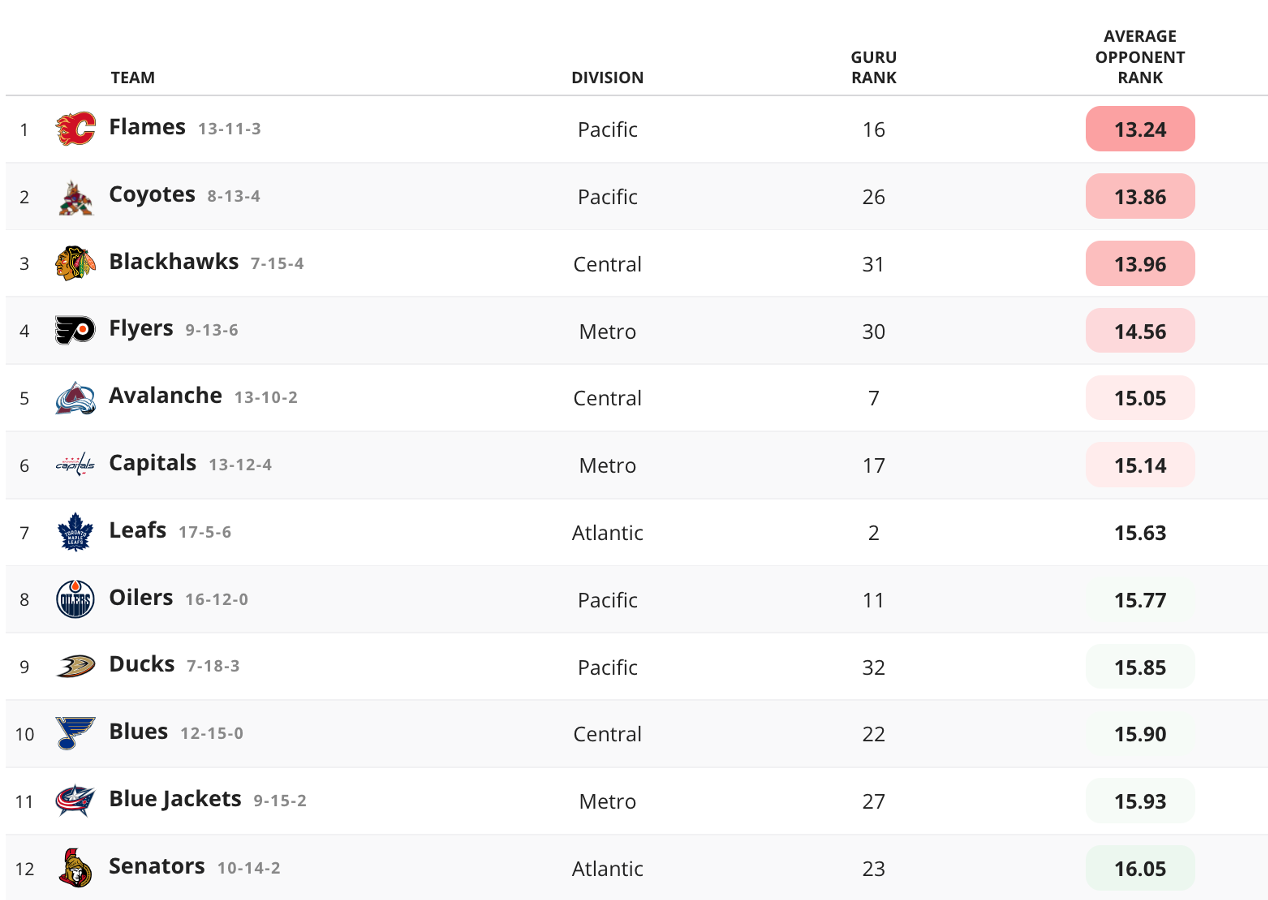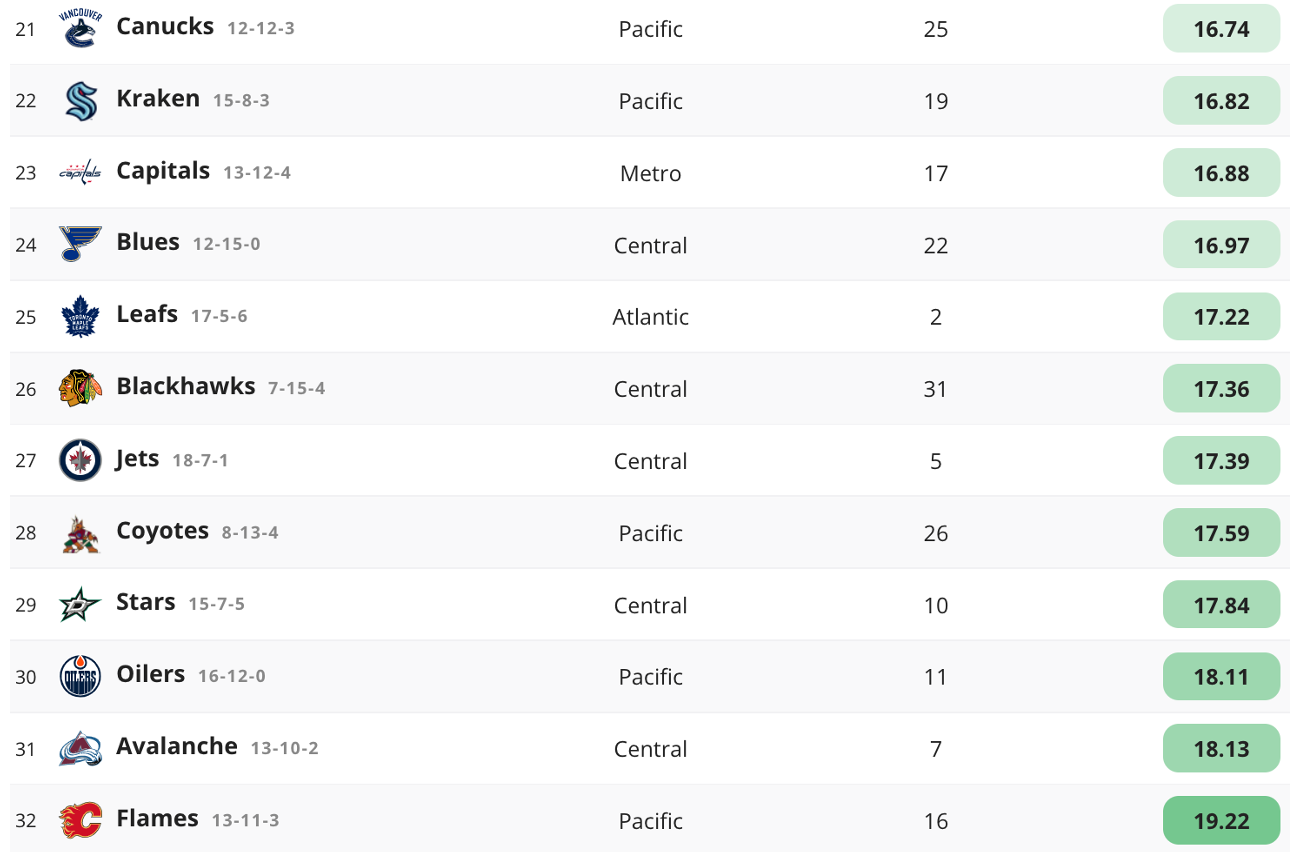
It can be a struggle to assess the standings early in the season — filtering out the signal from the noise is still a massive challenge. There are undoubtedly some who look just at the records and points and go “Holy, look at (Not Very Good Team X), this is their year!” And frankly, you don’t want to be that person.
After two weeks of hockey the Atlantic looked like maybe a surprising contender or two or three might really rise up. This is what the landscape looked like on Oct. 26, sorted by points:
Montreal won their next couple games and climbed, and some reacted accordingly (with surprise at the division’s standings). Nobody wants to cross-check everyone’s schedule and pull a Debbie Downer “Well actually” because one team has played a softer schedule than another.
But that’s life in the NHL. The reason everyone plays against every team and has comparable schedules is that there are hard stretches against good teams and the opposite for everyone. It’s an analyst crutch for me when asked if I’m a believer in a team or not – often I’ll express doubt about a team that’s had a cake schedule and is about to run into tougher competition.
Now, one more point on this: you can only play who’s on the schedule, which leads me into the first of many points I’ll be making here. The New Jersey Devils are for real, as they’re beating the high holy heck out of every opponent they face. But they have had the easiest schedule in the league, according to Power Rankings Guru, the site I typically check for this sort of thing. You can check what goes into their ranking system here, but it’s basically a compilation of the rankings of the teams from several websites. It’s not perfect, but it’s going to get us close to the reality of the situation, at least close enough to say the teams at the extreme ends have probably faced harder/lighter competition.
Here are the teams who’ve played the easiest NHL schedules (starting at the bottom, where you’ll find the “32nd hardest schedule”) as of Monday, since we talked Jersey:
You see three Canadian teams here: the Habs, who’ve had the fifth-easiest schedule of any team so far, and back in 11th and 12th are the Canucks and Jets. So, what does this mean for these teams the rest of the way?
Not much for those Canadian teams who fall into the middle of the pack from here on out, but the rest of this may be the most interesting table in this article. Here are the most difficult remaining schedules in the league:
That means Connor Bedard going to the Habs cannot be ruled out yet. They’re currently five points out of a wild card playoff spot, and ahead of Buffalo, Philadelphia, Ottawa, and Columbus in the East. Outside the woeful Blue Jackets – and maybe the Flyers? – I don’t think the Canadiens finish the year where they’re currently at in the standings, as positive as developments have been thus far.
Further to teams you can expect to have a tougher road ahead, though: by points percentage the Red Wings currently hold the last playoff spot in the East, but things are going to get harder still. And the Devils are going to head into the meat of the season playing against very good teams who are going to be more prepared for them. I do expect New Jersey to come back to the pack from being an .800 winning percentage team that’s currently sniffing around for the Presidents’ Trophy.
For fans of New York hockey, at least you’re in the “tough road ahead” boat with the fans of your rival team, anyway?
Now let’s look at who’s had the hardest chunk of their season off the start, then we’ll get into the flip side of that. It’s been heavy lifting so far in Alberta:
You can find four Canadian teams among the dozen who’ve played the hardest schedules to date, but Calgary’s place is particularly noteworthy.
The Flames had a major roster revamp and took that challenge into games against some of the best teams in hockey through more than a quarter of the season. It’s not easy to find yourself when you’re on your heels, though you would have a pretty darn good idea where the holes are awfully quick. Hopefully Darryl Sutter hasn’t been too hard on the group while they’ve been searching for answers.
Also noteworthy here are the Avalanche, who’ve been criminally injured, to the point it’s almost laughable, and have played a tough schedule to boot (shout-out to Washington for the same). If the Avs get healthy right as their schedule softens up and go on a second half tear, do you want to be the team that plays a suddenly healthy/confident Colorado team in playoffs? (You do not.)
The Avs have the second-easiest remaining schedule, while Calgary and Edmonton see a much lighter load ahead as well. Don’t expect Dallas to die off entirely, and there are two other things I notice here: don’t count out the St. Louis Blues or the aforementioned Capitals. The latter is starting to put some wins together (four wins in a row), and the Blues just have too good of a roster to not string together enough wins to get into the playoff picture (barring selling off pieces before it can happen).
The question is, how different are the schedules of these teams really, when there are still 50-plus games to go? Save for those teams on the extremes, the schedules won’t be that different. Plus, you never know who’s going to see teams when they’re at their healthiest, or when they’re slumping, or whatever. This is a very surface level look at what’s happened, and what’s coming.
But there is good information to be found in evaluating strength of schedules, some of which I’ve highlighted above. Some is useful in predicting the NHL, like with Vegas seeing the third-easiest schedule in the league so far, and with Calgary and Edmonton still having that stretch coming. Could those Canadian teams play catch up?
Everyone plays everyone in the end, but a look at these tables can help you guess which teams are due to rise, and which may fall.


